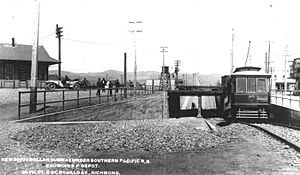East Shore and Suburban Railway facts for kids
The Eastshore and Suburban Railway (E&SR) was a streetcar system that operated in the San Francisco Bay Area. It ran electric trains, called streetcars, in cities like Richmond, California, San Pablo, and El Cerrito. The E&SR had several lines that connected different areas, including Point Richmond, North Richmond, and the county line with Alameda County.

If you wanted to go to Oakland, you had to switch to trains run by the Oakland Traction Company at the County Line station. For San Francisco, you needed to make another transfer in Oakland. Later, the E&SR became part of the larger Key System.
The streetcar service started to be replaced by buses on August 1, 1932. Lines were slowly changed over to buses, with the very last streetcar line stopping service in September 1933. Fares were originally 5 cents and later increased to 7 cents.
Contents
History of the Eastshore and Suburban Railway
Early Plans and Start of Service
Building the Railway
In 1900, a plan to build a street railway for the Eastshore and Suburban Railway was approved. However, there were some legal issues because the planned route needed to cross the Santa Fe Railroad tracks.
Standard Oil's Role
On January 10, 1902, William S. Rheem, who was the president of the Standard Oil refinery (now known as Chevron), started the Richmond Belt Line Railroad. This was to help provide transportation to the refinery.
In 1904, Rheem bought the rights to build the street railway. He then officially created the East Shore & Suburban Railway.
First Streetcar Runs
The East Shore & Suburban Railway began operating on July 7, 1904. The first streetcars ran from the Standard Oil refinery in Point Richmond to the Southern Pacific train station at 18th & Macdonald. Many people from the town came out to celebrate the opening day. The fare for a ride was five cents.
Expanding the Lines
New Routes in 1905
In January 1905, two new streetcar lines were added. One line went north from 6th & Macdonald to North Richmond, near the Santa Fe tracks. The second line ran west on Ohio Street from 3rd & Ohio. This area was popular for dining, dancing, and drinking at Maple Hall. Sometimes, extra streetcars were needed to take everyone home!
In October 1905, a big new extension opened. It went east on Macdonald Avenue to San Pablo Avenue, then south on San Pablo Avenue to the county line between Contra Costa and Alameda counties. At the county line, passengers could switch to another streetcar to go to Oakland.
There was a rule in Richmond that streetcars full of people couldn't cross the Southern Pacific tracks at 18th Street. So, passengers had to get off one streetcar, walk across the tracks, and get on another streetcar.
By December 1905, two more extensions were added. The Ohio Street line was extended east, and the 6th Street line was extended south.
Developments in 1906
In January 1906, plans began for a "subway" on Macdonald Avenue. This subway would go under the Southern Pacific tracks. It would allow the East Shore & Suburban streetcars to avoid crossing the busy train tracks.
A new line to San Pablo started in February 1906. It ran north on 23rd Street from Macdonald, then turned east on Market Avenue.
The Ingersoll-County Line station was built on San Pablo Avenue at the county line. It was covered to protect passengers from the weather while they switched between the Oakland and Richmond streetcars. The station was named after Mr. Ingersoll, a very popular conductor.
Eastshore Park and the Earthquake
On February 17, 1906, the East Shore & Suburban bought land in Stege to build "Eastshore Park." Construction of the park, which included a dance pavilion and a roller skating rink, started in March. A new streetcar line was also built to take passengers directly to the park. Service to Eastshore Park began on April 1, 1906.
Just a few days later, on April 6, 1906, the famous 1906 San Francisco earthquake happened. The East Shore & Suburban quickly helped by carrying many people to a refugee camp called "Camp Rockefeller" in San Pablo. This camp was set up by Standard Oil for those who lost their homes.
Subway Construction and Expansion in 1907
On September 1, 1907, the contract was signed to build the subway on Macdonald Avenue under the Southern Pacific tracks. This was a big step to make travel smoother and safer.
In October 1907, the western end of the streetcar line was extended further into the Standard Oil refinery.
Later in 1907, a man named John Nicholl announced plans for a competing streetcar company and ferry service. However, Col. Rheem, who owned the East Shore & Suburban, quickly bought Nicholl's new company, keeping the E&SR as the main streetcar service in the area.

